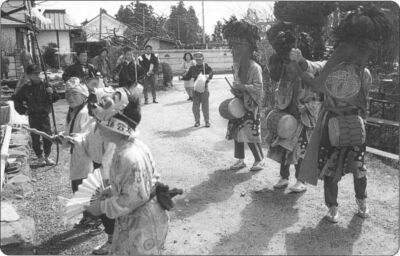(4)一143第二のグループは堂島(どうじま)村にまとまるもので、郡山(こおりやま)村、代田(よだ)村、谷沢(たにさわ)村、岡田(おかだ)村、大田原(おおたわら)村、広野村、熊野策(くまのどう)村、福島村からなります。
The second group of the Dojima-village consisted of the Koriyama-village,the Yoda-village,theTanisawa-village,the Okada-village,the Otawara-village,the Hirono-village,the Kumanodo-village and the Fukushima-village.
(4)一144当時の人口(じんこう)は、日橋(にっぱし)村が3,050人、そのうち1,126人が八田(はった)村です。
The population of the Nippashi-village was 3,050,and 1,126 out of 3,050 was the population of the Hatta-village at that time.(4)一145堂島村が2,501人、そのうち493人が福島村です。
The population of the Dojima-village was 2,501,and the Fukushima-village was 493.
(4)一146この日橋村と堂島村が昭和(しょうわ)32年に一緒になって河東村になりました。
The Nippashi-village and the Dojima-village were combined and they became the Kawahigashi-village in the 32nd year of the Showa era.
(4)一147河東村は、昭和53年に福島県で52番目(ばんめ)の町になり、河東町となりました。
The Kawahigashi-village became the 52nd town in the 53rd year of the Showa era.
(4)一148河東町の槻橋(つきはし)には彼岸獅子(ひがんじし)が伝えられています。
Higan-jishi was introduced to Tsukihashi in the Kawahigashi-town.
(4)一149彼岸獅子は、会津地域(ちいき)で春の彼岸(ひがん)に舞(ま)う民俗舞踊(みんぞくぶよう)です。
Higan-jishi is a folk dance performed in the Aizu area at the celebration of the vernal equinoxcalled Vernal Equinox Day.
(4)一150彼岸とは春分(しゅんぶん)の日と秋分(しゅうぶん)の日の前後(ぜんご)1週間の時期(じき)をいいます。
Equinox celebrations are held 1 week before the vernal and autumnal equinoxes and 1 week after of those.
(4)一151春分とは3月21日頃で昼と夜の長さが同じ日です。
The length of the daytime and the nighttime is the same on Vernal Equinox Day.
(4)一152彼岸は、気候(きこう)の境目(さかいめ)の時期です。
The equinoctial week is the period marking the change of the climate.
(4)一153「暑(あつ)さ寒(さむ)さも彼岸まで」と昔から言い伝えられています。
It had been said,that"Neither heat nor cold lasts over the equinox".
(4)一154春分の日を過(す)ぎると冬の寒さはもどってきません。
After the vernal equinox,it becomes warmer.
(4)一155彼岸獅子は、春に舞う獅子舞(ししまい)です。
The dance performed during the equinoctial week is a ritual dance with a lion mask.
